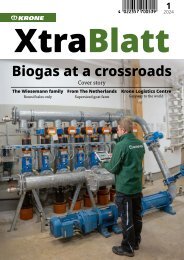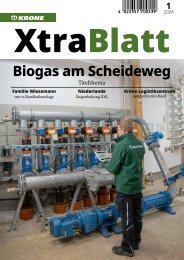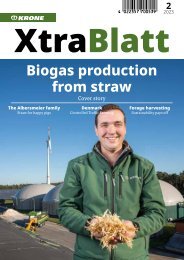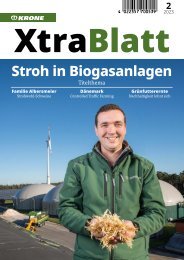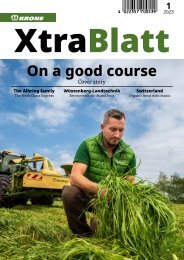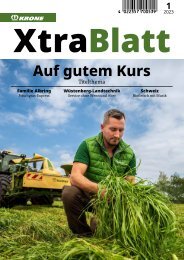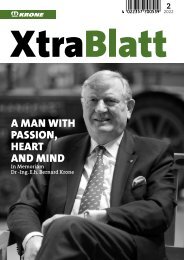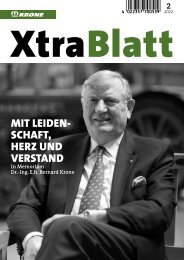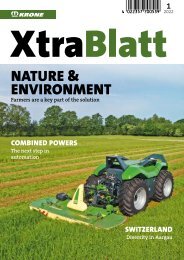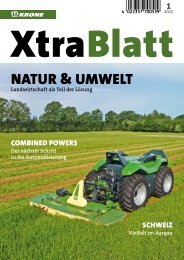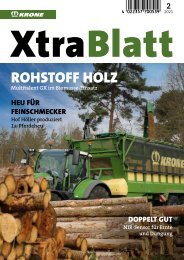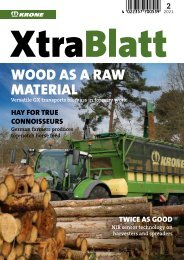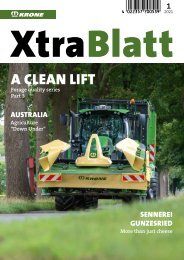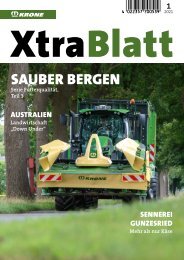XtraBlatt Issue 02-2020
You also want an ePaper? Increase the reach of your titles
YUMPU automatically turns print PDFs into web optimized ePapers that Google loves.
ON-FARM<br />
HAY HEINRICH<br />
FARMING – CONSERVATION –<br />
ADDING VALUE<br />
It’s generally accepted that the content<br />
in small packages is often substantially<br />
dearer than that in larger containers.<br />
This applies to hay too. By text deadline<br />
for this issue of <strong>XtraBlatt</strong>, first-cut hay in<br />
large square bales averaged just under<br />
160 €/t. On his website, “Hay Heinrich”<br />
sells his organic mountain meadow<br />
hay for 1.50 to 3.00 €. Per kilogramme!<br />
Safe to say, this represents a more than<br />
respectable margin. But the business isn’t<br />
as straightforward as it seems. Until the<br />
hay lies ready for sale in the shop shelves,<br />
a lot of work has to be done. And a fair<br />
portion of know-how is needed, too.<br />
ECONOMIC<br />
CONCEPT<br />
Heinrich Meusel doesn’t come from a<br />
farming background. His grandfather was<br />
botany professor and while his father is, in<br />
fact, an agricultural engineer, his main activity<br />
for a long time has revolved around<br />
landscape conservation, his full-time post<br />
being managing director of the Naturpark<br />
Thüringer Wald e. V. (Thuringia Forest<br />
Nature Park). He is also honorary member<br />
of the board for the German Landscape<br />
Conservation Association and the Foundation<br />
for German Landscapes. So, a family<br />
connection is definitely present. “I’ve<br />
always been happy working with hay”,<br />
reports Heinrich Meusel. “Even as a kid,<br />
I improved my pocket money by cutting<br />
mountainside meadows with a single-axle<br />
mower and then making hay. This fired my<br />
ambition to be a farmer. The appropriate<br />
education I underwent in the Austrian<br />
uplands. Hereby, it became increasingly<br />
clear to me that my interests lay not only<br />
in nature conservation, but also strongly<br />
in the machinery aspects. And I aimed to<br />
apply this through an economically viable<br />
business concept. Even then, I didn’t want<br />
to rely on just farm subsidies. This is how<br />
I arrived at the production of hay for pets<br />
as an enterprise.”<br />
Heinrich Meusel registered his first company<br />
at 17 years of age. The beginnings<br />
were modest. Initial mechanisation was a<br />
single-axle mower, later joined by a small<br />
tractor, then a tractor of Russian origin.<br />
Finally, a “real” tractor could be bought in.<br />
The first specialised machine was a Metrac<br />
bought second-hand in Switzerland. “I<br />
started without any land and no capital<br />
either”, Heinrich Meusel remembers. “It<br />
wasn’t easy to get credit and was quite<br />
normal to sell off machinery at the end of<br />
the season so that starter capital would be<br />
available for at least part of next season’s<br />
purchases.” In the meantime, the implement<br />
fleet has substantially expanded<br />
Heinrich Meusel worked with hay even<br />
as a child, then as teenager. And he was<br />
brought back to hay later during his search<br />
for a viable farm business model. He sells<br />
his production as pet feed through grocery<br />
retailer chains.<br />
46 47



